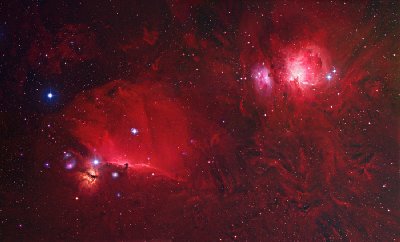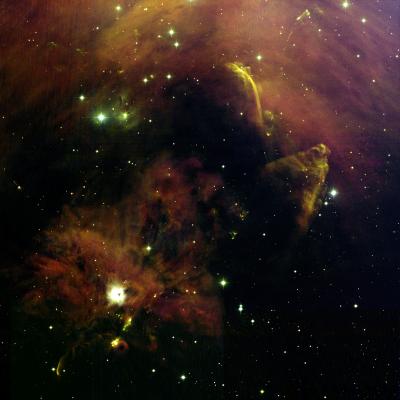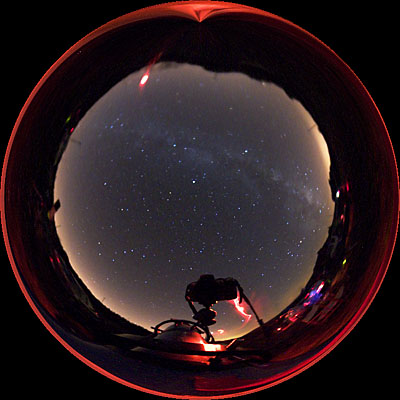Região de Orionte

Crédito: Robert Gendler (http://www.robgendlerastropics.com/ ) - copyright.

The four super-massive stars in the Orion Nebula form a rough trapezoid called the Trapezium. The curved bright lines in the image are bow shocks. Note how all the bow shocks face inwards toward the brightest star, which produces a stellar wind that is millions of times more dense and energetic than the solar wind. Credit: C. Robert O’Dell/Vanderbilt University

This new Hubble image of the Orion Nebula shows dense pillars of gas and dust that may be the homes of fledgling stars, and hot, young, massive stars that have emerged from their cocoons and are shaping the nebula with powerful ultraviolet light. Credit: NASA, ESA, M. Robberto (Space Telescope Science Institute/ESA) and the Hubble Space Telescope Orion Treasury Project Team

This young star in the Orion Nebula is ejecting material in narrow jets from both poles. The presence of a strong cross-flow is shown by the bright bow-shock on the stars left. As a result of this cross-current, both jets bend to the right. Credit: C. Robert O’Dell/Vanderbilt University
 | New Image Penetrates Heart of Orion Nebula By SPACE.com Staff posted: 10 February 2010 07:25 am ET |
This penetrating view of the Orion Nebula — a vast stellar nursery about 1,350 light-years from Earth — comes from the Visible and Infrared Survey Telescope for Astronomy (VISTA), the newest addition to the European Observatory's Paranal Observatory in Chile.
Although the nebula is spectacular when seen through an ordinary telescope, what can be seen using visible light is only a small part of a cloud of gas in which stars are forming. Most of the action is deeply embedded in dust clouds and to see what is really happening astronomers need to use telescopes with detectors sensitive to the longer, infrared wavelength radiation that can penetrate the dust.
Formação de estrelas em L1641N/NGC 1999
2010-09-10
Crédito: T.A.Rector, B.Wolpa, G.Jacoby (NOAO/AURA/NSF) & Hubble Heritage Team (STScI/AURA/NASA).
Telescópio: 0.9m KPNO.
Imagem do Dia: Todo o Céu
2010-06-30
Crédito: Filipe Alves
Formação de estrelas em L1641N/NGC 1999
2010-09-10
Crédito: T.A.Rector, B.Wolpa, G.Jacoby (NOAO/AURA/NSF) & Hubble Heritage Team (STScI/AURA/NASA).
Telescópio: 0.9m KPNO.
Outras Imagens do Dia:
2010-09-09 - RCW38 em infravermelho
2010-09-08 - Apolo 8
2010-09-07 - Gassendi
2010-09-06 - As temperaturas de Saturno
2010-09-05 - Nebulosa da Roseta
2010-09-04 - Aglomerado globular M 3
2010-09-03 - NGC 1275 - Colisão de galáxias
2010-09-02 - Nebulosa de Eta Carina
2010-09-01 - Cometa Ikeya-Seki
2010-08-31 - Aglomerado globular M 10 (NGC 6254)
2010-09-09 - RCW38 em infravermelho
2010-09-08 - Apolo 8
2010-09-07 - Gassendi
2010-09-06 - As temperaturas de Saturno
2010-09-05 - Nebulosa da Roseta
2010-09-04 - Aglomerado globular M 3
2010-09-03 - NGC 1275 - Colisão de galáxias
2010-09-02 - Nebulosa de Eta Carina
2010-09-01 - Cometa Ikeya-Seki
2010-08-31 - Aglomerado globular M 10 (NGC 6254)
Fonte:
Portal do Astronomo - Portugal
http://www.portaldoastronomo.org/npod.php?id=2837



Nenhum comentário:
Postar um comentário
Quer comentar,o espaço é todo seu!